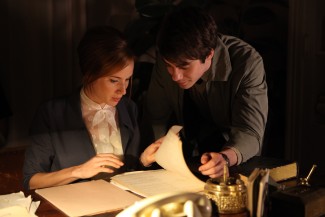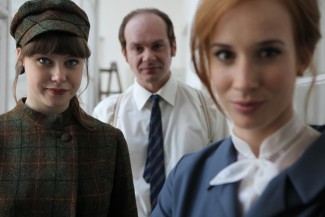INTERVIEW: Agnieszka Holland revisits Prague protests of her youth

Agnieszka Holland, the celebrated director of Europa Europa and In Darkness, returns to American movie theaters with the expansive historical docudrama Burning Bush. The movie, currently playing in two parts at New York City’s Film Forum, depicts the tumultuous events of the political situation in Prague in early 1969. The movie’s subject is Jan Palach, a Czech student who sets himself on fire to protest the occupation by the Soviet military.
Holland approached the movie not only from the safe distance of a contemporary film director but also from a personal angle. She was present in Prague at the time of the historic student protests. She was arrested. She faced the uncomfortable reality of the Cold War on a daily basis. Burning Bush is about Palach and the consequences of his actions, but it’s also a deeply personal invitation to experience this historical period from a person who lived through the action.
“I’ve been a student in Prague film school in late ‘60s, early ‘70s, exactly when the events which are described,” Holland said recently during a Skype interview. “I was not only a student there at the film school, but I was also very young, very sensitive and very curious person, and I was involved in the student movement. So I knew some players of this story, and it was for me the first and very important political and social experience of the kind. So it was always an important story to me, and I kept touch with some Czech friends.”
Holland called the so-called “normalization” of Czechoslovakia “totally normal political oppression,” and it was these vivid political times that she wanted to depict.
“I never thought that I would be able to tell this story as is because, you know, I left Czechoslovakia,” she said. “I never came back to Czech Republic to live there. And it was only like a few years ago, and some guy wrote to me asking if he can send me the script about Jan Palach. I said yes. He sent me the script. I read it, and I found it very interesting. And it was the first version of Burning Bush. I didn’t know who was the writer. I didn’t know what was the reality of the project, but I answered that I liked it and I can discuss it. A few days later, I had the letter from the two producers of this guy telling me that they are negotiating with HBO Europe, and if I’m interested, they are totally thrilled because they think I’m the only person in the world who can tell this story in credible way and cinematically and also in terms of the reality.”
That letter arrived when Holland was in Warsaw still finishing her movie In Darkness. The writer, Štěpán Hulík, and two producers, Tomáš Krubý and Pavla Kubečková, traveled by train from Prague to Warsaw.
“When I opened the door of my apartment in the morning I found three extremely young people, you know, like high school students, and that was the writer and two producers,” Holland remembered. “And they originated this project. So we had really great talk, and I gave some remarks about the script. And we agreed that we would try to do it together.”

Holland approached the film not as a postcard to a bygone era. She said that the past is “not really the past.” The events of the 20th century continue to evolve in 2014. However, by portraying them on film, she is offering preservation to these characters and occurrences.
“This story was not told really. There were some really superficial documentaries about it, but most people didn’t really know this particular story. And I like that it’s not the story of young Palach himself, but the consequences — human, political, social — of his act. And I thought that to tell this story wakes up a lot of questions in modern Czech society at least, a post-Communist society. What are our rules? What is the price of the courage? What kind of self-oppression was able to break the life of generations? And so on and so on.”
With the recent news about the Russia-Ukraine conflict, Holland sees the events of Burning Bush continuing for decades. “So politically speaking, I think that it’s important to tell this story. But, of course, I can tell this story, this particular story, when I feel that I have the filmmaking reason, and energy and passion to do so. I am many things in one. I am a filmmaker. I am a storyteller. I am the political person, and I’m also somebody who gives the justice to the people who will be forgotten if we’re not talking about them and to the events and mechanisms which will be forgotten or not understood if we would be silent about them. … But, of course, coming back after 40 years to those events, and feelings, and tastes and smells, it was interesting and intense.”
Besides the requisite cliffhangers at the end of each part, the process of creating the TV movie was the same as her other projects, which include Angry Harvest, among other Academy Award-nominated films.
“The language is the same. The way I make the choices about locations, about the pace, about the editing, about the actors, about the visual side, everything is the same. It was long time ago when, for example, doing things for television you did more close-ups because the TV sets were imperfect. Now we have HDR, even better, and people are watching TV, they are watching big TVs. Even if they are watching tablet, they are watching high quality.”
Because Burning Bush runs 240 minutes, Holland was able to finely focus on each character and plot point. This length of time allowed her to go deeper into the “psychology” of each person on screen.
“In some ways, it’s a bit conventional that the movie has to be 70 and 120 something minutes,” she said. “When you are writing a book, novel, some books have 100 pages and some have 500 pages. Of course, the question is are the people ready and capable to watch such a long time in the movie theater? I think it depends on two things. It depends if the storytelling has invention, and we screened this movie in one … [at] several American festivals, you know, in Telluride, in New York and Toronto. And the audience, practically very few people left. So the audience was really, you know, kept by the story. You need comfortable seats that your ass doesn’t hurt. If you are comfortable, and if you have time, and if the movie is well told, well narrated, I think it’s not a problem.”
More than the overall length of the project, Holland found her greatest challenge shooting the opening scene of the miniseries. The director wanted to depict the moment when Palach sets himself on fire with great care. “That was the most difficult technically and also how to do it right,” she said.
The resulting images are horrifying and speak volumes to the political atmosphere in Prague in the late 1960s. The nation was transformed by Palach and his contemporaries. Today, Holland looks back at those events with the advantage of 40 years of perspective.
“It was to me totally understandable that you can do it, and if somebody would ask me this time to be part of this conspiracy, of this group, I’m pretty sure I would say yes,” she said. “Of course, today I would not say yes. I’m much closer to those people who know the consequences and price of these kinds of choices. … On the other hand, I know how high the price you are paying for betraying yourself, for being corrupted, or for being conformist. So, yes, I know much more today, and I understand those people better. And, of course, my choices today would be human choices. It would be probably different than in this time, but my experience and lesson I had from observing several extreme situations is that you don’t know what you will do before you really face this choice.”
By John Soltes / Publisher / John@HollywoodSoapbox.com
-
Click here for more information.

